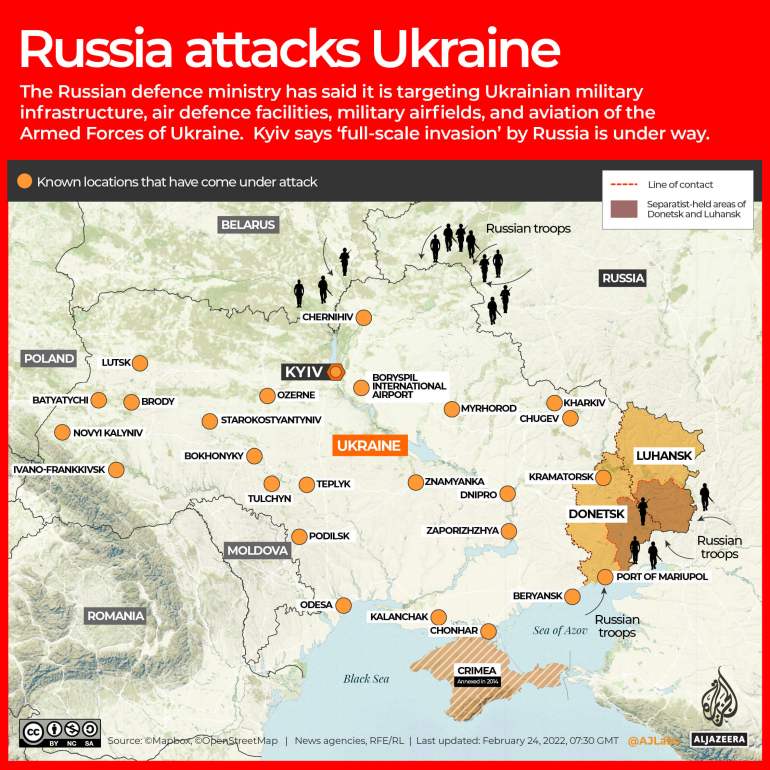Chernobyl nuclear plant targeted as Russia invades Ukraine
Major gun battle breaks out between Russian and Ukrainian forces at the stricken radioactive site, with its safety status now unclear.

Fighting broke out after Russia invaded Ukraine at the Chernobyl nuclear plant where radioactivity is still leaking from history’s worst nuclear disaster 36 years ago.
Russian forces took control over the site after a fierce battle on Thursday with Ukrainian national guards protecting the decommissioned plant, Ukrainian presidential adviser Mykhailo Podolyak said.
Keep reading
list of 4 items‘Rooted in NATO’: Iran responds to Russia’s Ukraine attack
Russia and the West are moving towards all out economic war
Biden unveils new Russia sanctions over Ukraine invasion
The condition of the plant’s facilities, a confinement shelter, and a repository for nuclear waste is unknown.
Igor Novikov, a former adviser to President Volodymyr Zelenskyy, said the threat to Europe from the incapacitated nuclear facility needs to be taken extremely seriously.
“I’d say first and foremost we need help explaining the dangers to our friends in the West. I mean, Ukraine has 15 active nuclear reactors and nuclear waste in Chernobyl: one mortar miss, and everyone in Europe is facing a major nuclear catastrophe,” Novikov told Al Jazeera.
“I’d ask everyone to speak with your political representatives, your friends and peers. Everyone should understand that it’s not only about Ukraine, the whole of Europe is in major danger.”
President Volodymyr Zelenskiy said Ukrainian forces were fighting to prevent Russian troops from capturing the former nuclear power plant at Chernobyl https://t.co/hE833fxPp6 pic.twitter.com/zM0gP8KdoJ
— Reuters (@Reuters) February 24, 2022
‘Tragedy of 1986’
An official familiar with current assessments said Russian shelling hit a radioactive waste repository at Chernobyl, and an increase in radiation levels was reported. The increase could not be immediately corroborated.
A senior American intelligence official said the US believes Russian forces at Chernobyl were aiming to push to Kyiv, 130km (80 miles) away, to try to link with other Russian forces throughout Ukraine. The officials were not authorised to be publicly named discussing the sensitive matter.
The Chernobyl Exclusion Zone, a 2,600-square-kilometre (1,000-square-mile) zone of forest surrounding the shuttered plant, lies between the Belarus-Ukraine border and the Ukrainian capital.
Ukrainian President Zelenskyy said Ukrainian officers fought to defend it, “so that the tragedy of 1986 will not be repeated”. He called it a “declaration of war against the whole of Europe”.
Radioactive dust
Podolyak said after an “absolutely senseless attack … it is impossible to say that the Chernobyl nuclear power plant is safe”. He warned Russian authorities could blame Ukraine for damage to the site or stage provocations from there.
Ukrainian Interior Ministry adviser Anton Herashenko warned any attack on the waste repository could send radioactive dust over “the territory of Ukraine, Belarus and countries of the EU”.
Russian officials, who have revealed little of their operations in Ukraine and not revealed their goals, did not publicly comment on the battle.
Edwin Lyman, director of nuclear power safety at the Union of Concerned Scientists in Washington, DC, said, “I can’t imagine how it would be in Russia’s interest to allow any facilities at Chernobyl to be damaged.”
Lyman said he is most worried about spent fuel stored at the site, which has not been active since 2000. If the power to cooling pumps is disrupted or fuel-storage tanks are damaged, the results could be catastrophic, he said.

Fallout danger
Reactor No 4 at the power plant exploded and caught fire deep in the night on April 26, 1986, shattering the building and spewing radioactive material high into the sky.
Soviet authorities made the catastrophe even worse by failing to tell the public what had happened, angering European governments and the Soviet people. The two million residents of Kyiv were not informed despite the fallout danger, and the world learned of the disaster only after heightened radiation was detected in Sweden.
The building containing the exploded reactor was covered in 2017 by an enormous shelter aimed at containing radiation still leaking from the accident. Robots inside the shelter work to dismantle the destroyed reactor and gather up the radioactive waste.
It’s expected to take until 2064 to finish dismantling the reactors. Ukraine decided to use the deserted zone as the site for its centralised storage facility for spent fuel from the country’s other remaining nuclear power plants.